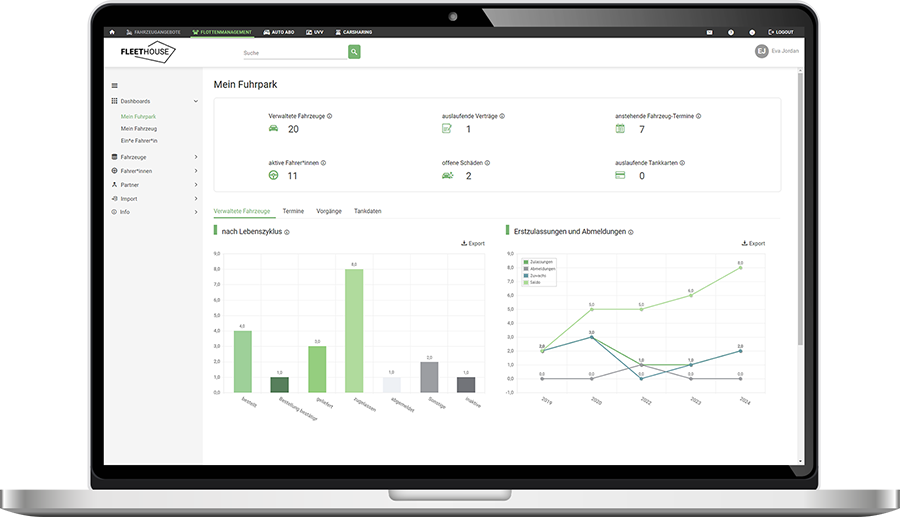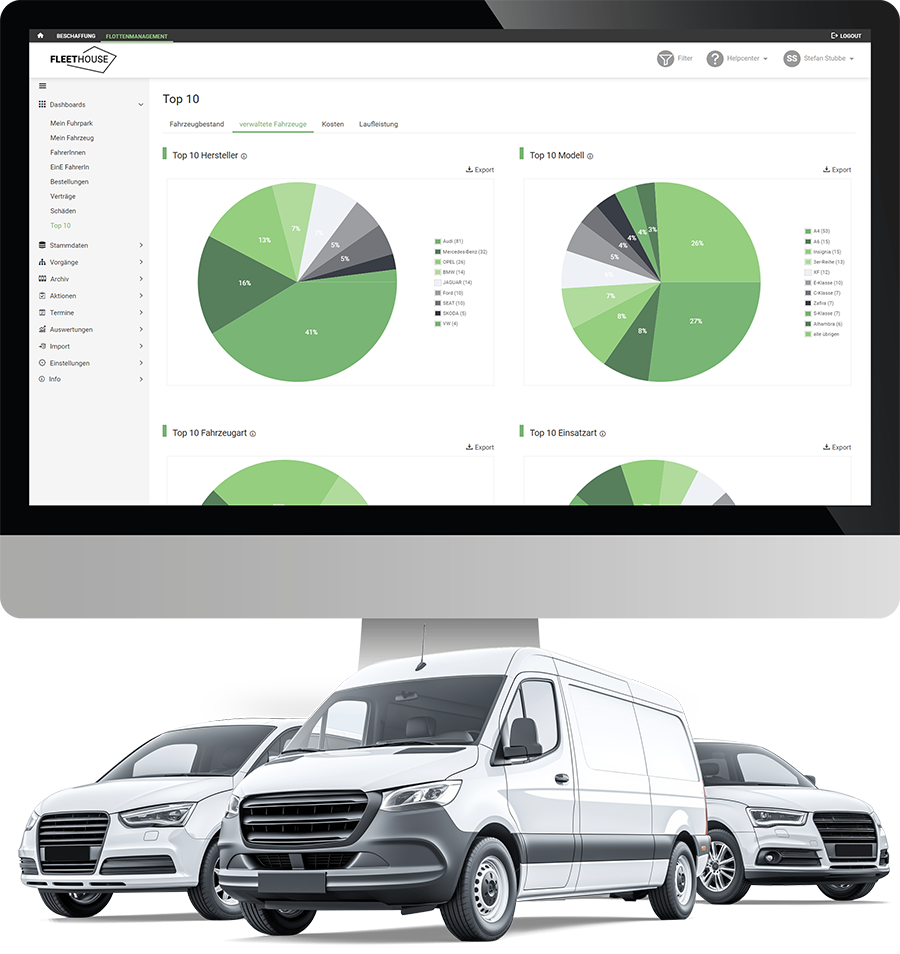Fleet management is extremely diverse and ranges from vehicle procurement and damage management to compliance with legal requirements. Even with just a few vehicles in the fleet, the workload can quickly become enormous. Digital solutions provide support here, relieving the burden on fleet managers and ensuring a better overview.
Today, modern fleet management is much more than just managing individual vehicles – it is about the strategic management of the entire vehicle fleet in order to streamline processes, reduce costs and use resources efficiently. With the right fleet software, many tasks can be completed automatically. This not only ensures greater transparency, but also enables companies to maintain an overview of complex structures and make well-founded decisions.
In this article, you will find out what fleet management actually means and what tasks are involved in managing vehicles. We also give you tips on how fleet digitalization can succeed.
Contents
What is fleet management?
The term fleet management refers to the administration and organization of a company’s vehicle fleet. Fleet managers are responsible for managing the fleet efficiently and cost-consciously. When you manage a fleet, you are responsible for procuring vehicles, optimizing their use, coordinating maintenance and repair work, managing insurance matters and ensuring compliance with legal regulations.
What tasks are part of fleet management?
From the procurement of new company cars to the handling of claims and compliance with owner liability obligations, the tasks of a fleet manager are very varied and complex.
In a broader sense, fleet management encompasses all strategic and operational processes associated with the deployment of a fleet – from vehicle planning to dispatching. Modern systems support the automatic completion of many routine tasks and thus ensure smooth processing in day-to-day business. The fleet manager is increasingly becoming the central switching point between economic efficiency, sustainability and legal certainty.
This is not just about vehicle management, but about ensuring the mobility of all employees. Fleet management activitiesinclude:
Vehicle procurement
One of the fleet management tasks is the acquisition of suitable vehicles. This includes negotiating with suppliers and taking costs and operational requirements into account. It also includes choosing the form of procurement: Is leasing suitable for new vehicles or purchasing? Analyzing whether electric vehicles are suitable for fleet operations and how to integrate them effectively is also part of the fleet management tasks.
Deadline monitoring
Fleet managers have to keep an eye on important dates and deadlines, such as HU and AU appointments or driving license checks. Timely planning and reminders of these appointments are extremely important in order to disrupt operational processes as little as possible and to ensure sufficient safety in the fleet.
Maintenance and repair management
Regular maintenance measures and professional repairs are also part of fleet management. This ensures that the vehicles are ready for use and roadworthy at all times. This includes working with workshops, monitoring maintenance schedules and checking service quality.

Schadenmanagement
Kommt es doch zu einem Unfall, dann ist eine schnelle und reibungslose Abwicklung von Schäden im Fuhrpark Management wichtig. So können Fuhrparkverantwortliche unnötige Kosten vermeiden und die Mitarbeiter bleiben mobil.
Dokumentation
Ein weitere zentrale Aufgabe ist die Erfassung und Pflege von Fahrer- und Fahrzeugdaten. Auch eine ordnungsgemäße Dokumentation von Fahrzeugdokumenten, Unfallberichten, Wartungsprotokollen und anderen relevanten Unterlagen ist im Fuhrparkmanagement unerlässlich.
Halterhaftungspflichten
Wenn Sie einen Fuhrpark managen, spielt auch das Thema Halterhaftung eine wichtige Rolle, unabhängig davon wie viele Fahrzeuge das Unternehmen im Bestand hat. Neben der regelmäßigen Führerscheinkontrolle gehört zum Fuhrparkmanagement auch die UVV-Unterweisung aller Fahrer im sicheren Umgang mit Firmenfahrzeugen. Diese Pflichten sollten Fuhrparkverantwortliche nicht auf die leichter Schulter nehmen. Andernfalls drohen im Schadenfall empfindliche Strafen.
How do I digitize fleet management?
Even if the fleet only consists of a few vehicles, the automation of tasks and processes brings many advantages. The use of digital technologies and software solutions reduces manual and paper-based tasks in fleet management to a minimum, ensures greater transparency and increases efficiency. Ideally, the digitalization of fleet management should take place in stages:
1. needs analysis
First, take stock of your current fleet management processes and tasks. Which of these involve a particularly large amount of paperwork and time? Which of them can be digitized? Also ask yourself which functions the fleet management software needs to have. Do you need a module for the procurement of new vehicles, for fleet management or for compliance with owner liability obligations?
2. selection of suitable fleet software
Research software solutions that meet your requirements. Compare their functions, prices, user-friendliness and customer support. Choose the software that best suits your fleet management needs and meets your requirements.
3. implementation
As soon as you have found a suitable fleet management system, implement it in your company. Make sure that the software can be easily integrated into your existing IT systems.
4. data migration
Transfer your existing fleet data such as vehicle information, maintenance histories, driver data, etc. to the new software. For a smooth transition, it is important that the data is correct and complete. The data upload should be possible via Excel import or VIN query. Once the data has been uploaded, you can ideally get started straight away.

Digitize your Vehicle Fleet
Organize your vehicles and all insurance policies with Fleethouse: manage data centrally, keep an eye on all appointments and monitor costs.
How does fleet management software support me?
A fleet management system such as Fleethouse provides fleet managers with valuable support in their daily work, especially when the organization of vehicles is often done on the side.
By digitizing recurring tasks, many fleet management processes can be significantly simplified and in some cases controlled automatically. This not only reduces the administrative workload, but also ensures that fleet costs can be permanently reduced. For fleet managers, this means more time for strategic decisions and less manual routine work.
Central data management
Software enables centralized management of all vehicle and driver data in one place. Soe can easily record and maintain information such as vehicle type, license plate number, maintenance history or driver qualifications. Documents such as vehicle papers, insurance documents, accident reports and maintenance logs are also stored digitally and assigned to the vehicles. This saves valuable time in day-to-day fleet management and enables clear organization. Fleet managers can access these documents at any time and from anywhere without having to search through archives and folders.
Keep an eye on appointments
Fleet management software also takes care of reminders for important tasks and deadlines, such as due maintenance, vehicle inspections or driver instructions. This means that fleet managers do not overlook any deadlines, even if they are busy with other tasks.
Cost Control
In addition, a fleet management system supports you in monitoring fuel consumption and costs. By integrating fuel receipts and consumption data, fleet managers can analyze fuel consumption and identify potential savings. This helps to control costs, even with limited time resources.
Keep a logbook
For many companies, a correctly kept logbook is more than just a tax obligation – it is an important tool for cost control and clarity in fleet management. Especially when company cars are also used privately, the tax office requires complete documentation. Digital logbooks make recording easier and help to automatically document mileage, travel purposes and time periods. This not only relieves the burden on bookkeeping, but also reduces the risk of additional tax payments.
Reports and analyses
Thanks to informative reports, you can take a close look at and break down important key figures such as costs, vehicle usage and maintenance statistics in fleet management. Where are cost drivers hidden and in which areas can you reduce costs? Fleet manager receive a comprehensive overview of fleet operations and can make well-founded decisions.
Digital holder liability
Compliance with owner liability obligations is simplified through the use of modern software. These digital solutions ensure less effort and more safety in the fleet.
In our free guide, we give you tips on how a software solution can make your day-to-day fleet work easier: Getting started with digital fleet management
Digital fleet management: what are the disadvantages of Excel?
Excel is a widely used tool for organizing vehicles , but it quickly reaches its limits. This is because the tool does not offer sufficient functions for efficient fleet management and no automation options for carrying out time-consuming routine tasks digitally.
- Offers a limited number of functions
- Requires manual input and calculations, which is time-consuming and more error-prone
- Has limited options for securing data and protecting against unauthorized access – sensitive vehicle and driver data can be vulnerable to error, loss or unauthorized access in Excel spreadsheets
- As a stand-alone program, very limited when integrating other fleet management systems, such as telematics systems, fuel card solutions or accounting software.
- Updating vehicle data in real time is difficult and version problems are possible if several people are working on an Excel spreadsheet at the same time

Who is responsible for fleet management in the company?
Responsibility for fleet management is handled differently depending on the size and structure of the company. In larger companies, there is often a designated fleet manager who is responsible for fleet management and all associated tasks.
In smaller and medium-sized companies or if the vehicle fleet is not one of the core activities, fleet management is often done on the side. If there are only a few vehicles in the fleet or if the company is very small, it can also happen that the management takes over fleet management itself.
Regardless of the size of the company, it is important to define clear responsibilities – especially if pool vehicles are available in addition to classic company cars or the fleet is growing regularly. An experienced fleet manager can provide structure, efficiency and legally compliant administration – even if only a few vehicles are in use.
What dates and deadlines need to be kept in mind for fleet management?
As already mentioned, fleet management is all about keep an eye on various dates and deadlines. The most important dates include
- HU (main inspection): In accordance with the Road Traffic Licensing Regulations (StVZO), vehicles must undergo regular main inspections. The exact date of the main inspection depends on the vehicle type, the date of first registration and the vehicle class.
- AU (exhaust emissions test): The exhaust emissions test is required by law and is used to check the vehicle’s emission values. This ensures that the applicable environmental standards are complied with. The AU is now part of the HU.
- UVV inspection: During an UVV inspection, an independent expert checks various components of the vehicle to ensure roadworthiness and prevent accidents. These include the brakes, lighting systems, tires, steering, seat belts, warning signals and other safety-relevant components.
- UVV driver training: In fleet management, you must train all drivers at least once a year in the safe handling of vehicles and how to behave in the event of accidents. Such driver training in accordance with UVV is also required by law under accident prevention regulations.
- Driver’s license checks: Regular driver’s license checks are also mandatory in fleet management. This is to ensure that all drivers have a valid driving license and are authorized to drive the vehicle. The frequency of checks can vary depending on company guidelines, but it is recommended that checks are carried out every six months.

Do you want to manage your fleet efficiently?
Register with Fleethouse and manage your company vehicles completely digitally.
What role does sustainability play in fleet management?
Sustainability plays a key role in fleet management is playing an increasingly important role. Companies are aiming to reduce their environmental impact, save costs, meet legal requirements and strengthen their own image as a result.
Sustainable fleet management includes measures that reduce fuel consumption and environmentally harmful emissions and promote more environmentally friendly drive types and mobility concepts. By using energy-efficient vehicles and increasing vehicle utilization, companies can simultaneously reducetheir operating costs. In addition, a more sustainable fleet strengthens the company’s image. More and more customers and employees attach importance to companies that act with consideration for the climate and the environment.
Which mobility concepts are important for sustainable fleet management?
Fleet management now goes beyond the mere management of vehicles. Instead, fleet managers must take a holistic view of operational mobility and combine cost optimization, employee needs and sustainability goals.
Corporate car sharing
Corporate car sharing in the fleet allows vehicles to be used more efficiently. Instead of assigning each employee their own vehicle, the vehicles are available to all employees for shared use. This minimizes idle times and increases utilization. At the same time, the number of vehicles can be reduced and valuable resources saved.
Electromobility
The use of low-emission or zero-emission vehicles helps companies to reduce their carbon footprint and thus contribute to climate protection and the promotion of sustainable mobility. In addition, e-vehicles generally have lower operating costs compared to combustion engines and require less maintenance as they have fewer parts that are susceptible to wear and tear. However, it is important to consider the infrastructural requirements, such as the availability of charging stations, to ensure a successful transition to electric mobility in fleet management.
Car subscription
In order to test whether electric cars are suitable for the company’s own fleet or to bridge longer delivery times, electric car Car subscriptions a good alternative. You can rent the vehicle you want for a short period and test it extensively. After the subscription period, simply return it or exchange it for another vehicle.
Testing electric vehicles?
With a car subscription, you can test without obligation whether an electric car is suitable for your fleet. With no hidden costs and a term of just one month.
Checklist: Organize fleet management efficiently
A structured approach helps you to maintain an overview and organize your fleet management in an economical and legally compliant manner. The following checklist shows you step by step what you should pay attention to – from responsibilities to digitalization.
This allows processes to be optimized, errors to be avoided and the entire fleet to be managed economically in the long term.
- Clarify responsibilities – define responsibilities internally or externally
- Record vehicle stock – document all vehicles including data and status
- Plan maintenance and inspection appointments – HU, UVV, driver’s license checks, etc.
- Organize driver training – Conduct annual UVV training courses
- Integrate logbook & fuel cards – for better control and documentation
- Using digital tools – using software for automation and appointment management
- Coordinate pool vehicles – manage booking and use efficiently
- Analyze costs – check fuel, maintenance & insurance regularly
- Thinking about sustainability – checking alternative drives & route optimization
Professionally managed fleet management is much more than just vehicle management – it is a central component for targeted processes, legally compliant operation and sustainable mobility within the company. Whether it’s a small fleet or a large fleet: those who structure processes clearly, use software-supported solutions and reliably comply with legal requirements not only reduce costs, but also increase clarity and transparency in day-to-day operations. Take advantage of the opportunities offered by digitalization and make your fleet future-proof – economically, sustainably and with a strong foundation.
Arrange an online consultation appointment
Arrange your personal consultation appointment now. You can easily select a suitable appointment using our booking tool.

Anne Fuchs

Ciara Lazeta
FAQ - Fleet management
When choosing a suitable software solution for fleet management, you should make sure that it offers all the functions you need and has a modular structure. This allows you to add and remove the desired functions at any time.
The vehicle fleet is one of a company’s largest cost centers. Economical fleet management is therefore all the more important. By analyzing costs and consumption, you can find out where cost drivers are hidden. You can then plan and implement suitable optimization measures. In addition, vehicles should be regularly serviced and tire pressure checked. Corporate car sharing, i.e. sharing vehicles in the fleet, can also help to reduce operating costs.
In cooperation with the Bundesverband Betriebliche Mobilität e. V. and FIRMENAUTO, the DEKRA Academy offers the “Certified Fleet Manager (DEKRA) (m/f/d)” qualification. The content of the training is constantly being expanded and updated in line with current fleet management requirements. TÜV Rheinland also offers further training to become a fleet manager, in which practical knowledge in procurement, law, liability and cost and risk management is trained.
Structured fleet management is worthwhile from just a few vehicles – often from three to five vehicles in the fleet. The more vehicles in use, the greater the organizational effort. Digital solutions allow even small fleets to be managed efficiently, documented in a legally compliant manner and reduce fleet costs in the long term.
The most important facts about fleet management
The term fleet management is used to describe the management, control and monitoring of vehicle fleets.
In addition to the procurement of vehicles, fleet management tasks also include claims management, compliance with owner liability obligations, regular maintenance and servicing and cost monitoring.
With the help of a software solution, routine fleet management tasks can be automated, reducing the workload of fleet managers and saving time and money.
Further Fleet Knowledge
If you liked this article and would like to know more about fleet management, we recommend these articles.

Vehicle management: importance in the fleet and helpful tips

Fleet insurance for your vehicle fleet: this is what matters




